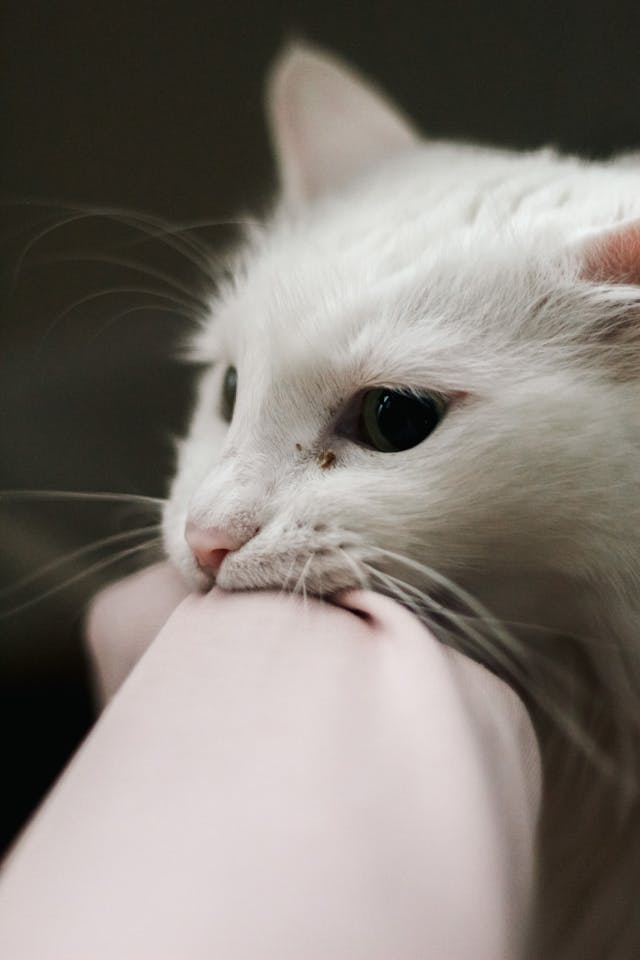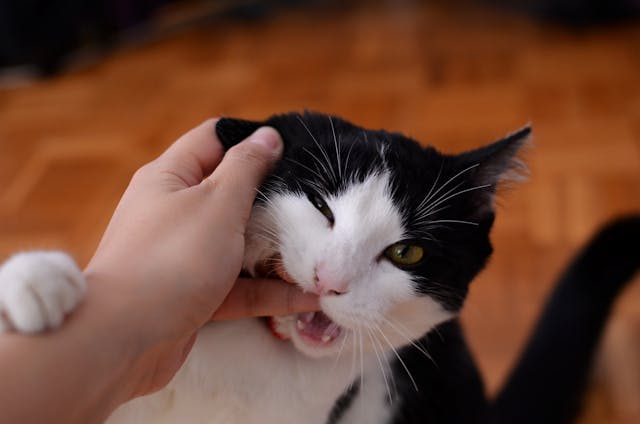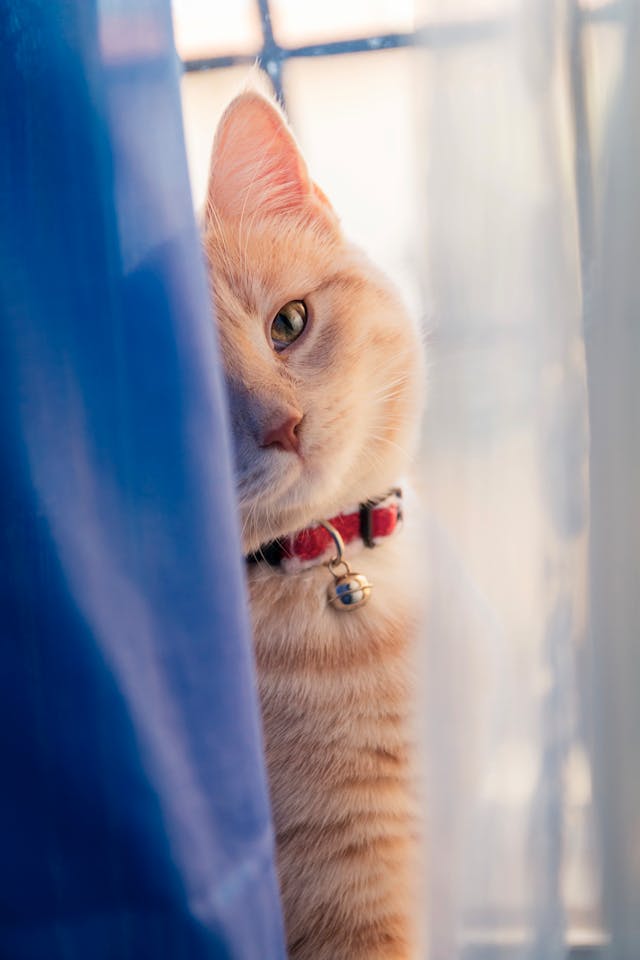Though they are adorable and cuddly, cats can bite with great force. We’re going into the sometimes disregarded dangers of cat bites in this blog post, and why every cat owner should be aware of them. We’ll go over all you need to know to protect yourself and your animal friend from infections to nerve damage. So fix yourself a cup of coffee and get ready to discover the hidden risks that those seemingly innocuous cat kisses have.
Overview of Cat Bites and Their Dangers
Love and happiness may fill your life in such abundance when you own a cat. Adorable, playful, and affectionate are these furry friends’ reputations. All the same, as much as we love our feline companions, it’s important to remember that they can be dangerous, especially when they bite.
Though most people don’t give cat bites much thought, if they aren’t handled properly, these apparently innocuous events can have major health consequences. Actually, cat bites were the source of more than 20% of all animal-related injuries needing medical attention, according to a 2014 Mayo Clinic research.
How Dangerous Are Cat Bites?
Cat saliva contains a variety of microorganisms that, upon biting, can swiftly enter human tissue. Pasteurella multocida is the most often occurring bacteria in their saliva and is the cause of human infections. Should these bacteria be allowed to proliferate and spread throughout the body, serious illnesses may result.
Furthermore, because cats can withdraw their sharp teeth when biting, these wounds frequently seem little on the surface. They can, nevertheless, penetrate the muscles and skin deeply. This facilitates the entrance of germs from their lips that might cause rabies or tetanus into human bodies.
Cat bites can result in other problems than bacterial infections and illnesses, such swelling and redness in the bite site. Sometimes more serious symptoms, such as a fever, chills, and exhaustion, might appear if the wound is neglected or gets infected.
Moreover, cats are seen as territorial creatures that could feel frightened by strangers or even during caring tasks like grooming or petting. Felines’ natural response in this defensive posture is to puncture wounds rather than scratches, which increases the chance of infection.
Even though cat bites might not seem like much at first, left untreated, they can be rather dangerous. The symptoms and warning indicators of a cat bite will be covered in the next section, along with appropriate treatment. Being conscious of these hazards and implementing the required safety measures can help to protect you and your cat friend.

Frequently Held Myths About Cat Bites Disproved
Most of us who love cats have had our feline pals give us tender love bites. Still, false beliefs about cat bites might have serious repercussions. Here we shall dispel some widespread misconceptions regarding cat bites and clarify the dangers connected to these seemingly innocuous actions.
The myth that cat bites are harmless.
One widespread myth is that cat bites are less dangerous than dog bites. Compared to dogs, which have strong jaws and may inflict serious puncture wounds, cats have smaller teeth and may appear to bite less forcefully. That does not, however, preclude their ability to do harm. Through their saliva, which may readily enter human circulation through even little scrapes or scratches from their sharp teeth, cats can spread a vast variety of bacteria. Untreated infections with these germs can be rather serious.
Myth: Playtime is when cats typically bite.
Even if a lot of cats do bite jokingly, it should never be accepted or normal. Being excellent hunters, cats emulate hunting techniques like pouncing and stalking in their play. If they feel threatened or overstimulated, though, this natural behaviour can easily turn into violent biting. Even play biting, though, can rip the skin and bring microorganisms into our systems.
Myth: A cat bite is safe if it doesn’t rip the skin.
Unbelievably, a cat bite can be potentially deadly even if it does not break the skin. If a cat bites you and you don’t notice any obvious signs or redness, bacteria in the mouth could still infect you.
The myth that rabies affects all cats.
Because they think all cats are rabies carriers, a lot of people are afraid of even little scratches or nibbles from their pet cats. Actually, just about 1% of cats in the US have rabies. It is still imperative, though, to exercise caution and maintain your cat current on all required immunizations.
The possible hazards connected to cat bites should be understood by cat owners and others who come into contact with them. While they could appear innocuous, improper treatment of cat bites can result in serious diseases. Whatever the extent of the cat bite, it is always preferable to get medical help. And never forget to train your animal companion and set limits to avoid any possibly dangerous circumstances in the future. Never discount or normalize biting behavior from them.
Cat Bite Infection Dangers
Even if they may appear innocuous, cat bites can be rather dangerous to our health. Though cats are popular pets and are generally thought of as kind animals, if their bites are not treated properly, they can become infected very rapidly. This section will go over the risks of cat bite infections and how to safeguard yourself.
The great chance of infection that cat bites carry is one of the primary reasons they are harmful. Bacteria from their mouths or surroundings can easily enter our bodies because of the sharp teeth of cats. Without appropriate care, an illness brought on by this bacteria can get severe very fast.
An infected cat bite often causes redness, swelling, discomfort, and warmth in the vicinity. You might also have a temperature, chills, or wound drainage. Untreated infection can travel to other areas of your body or even enter your circulation, which could be fatal.
The kind of bacteria that cats carry in their mouths adds still another risk to cat bites. Over 85% of domestic cat mouths contain the common bacteria Pasteurella multocida, which can cause up to 50% of cat bite diseases. Serious infections may also result from other bacteria found in a cat’s saliva, such Streptococcus pyogenes and Staphylococcus aureus.
Get medical help right away if a cat has bitten you in order to guarantee appropriate care and avoid any possible problems. In order to treat bacterial infections, your doctor might provide antibiotics, clean and dress the wound properly, or send you for more care.
Apart from bacterial illnesses, cat bites carry a chance of tetanus or rabies acquisition. The viral disease rabies damages the brain and neurological system and, if not treated right away, can be fatal. Commonly occurring in soil, tetanus can enter the body through open wounds and result in paralysis, rigidity of the muscles, and even death.
Taking proper wound care following a cat bite is essential to reducing these dangers. After giving the wound a good five minutes’ worth of soap and water, apply an antibiotic ointment and wrap it with a fresh bandage. Get medical help right away if you see any indications of infection or if the incision doesn’t heal in a few days.
Although at first look cat bites may appear innocuous, improper treatment might result in serious risks. We have to inform ourselves about the dangers of cat bites and take the required safety measures to prevent infections or other problems. If a cat has bit you, always get medical attention right once to guarantee a speedy healing.
Potentially Occurring Infections
Though seemingly innocuous, cat bites can cause serious and even fatal illnesses. This is so because a cat’s mouth is inherently populated with microorganisms, some of which are dangerous to people. As such, knowledge of the kinds of illnesses that can result from cat bites and how to avoid them is crucial.
A Pasteurella Infection: Cat bite infections most often result from Pasteurella bacteria. Cats among other animals have these germs in their mouths. An infection might result from introducing them via bite or scratch into a human body. At the bite or scratch location, symptoms include redness, swelling, and pain. Untreated, more serious symptoms including fever and joint discomfort may result.
Streptococcus Infection: Additionally typical in a cat’s mouth are Streptococcus bacteria. Through a bite wound, they can infect a human. Fever and enlarged lymph nodes close to the wound area are possible symptoms. Rarely, cat bite strep infections have been linked to more serious illnesses including sepsis.
A Staphylococcus Infection: Cat bites can also spread staphylococcus bacteria, much as strep infections do. These germs live on the skin and mucous membranes of cats and get into a human body through a bite wound. An infection resulting from this might cause fever, chills, edema, and redness surrounding the wound site.
Cat scratch disease, Nocardia and Bartonella henselae
The soil-dwelling bacteria known as Nocardia can infect cats when they play or hunt outside and come into touch with contaminated plants or dirt. They obviously underreported working too near to diseased contagious kittens, but other than immunocompromised people, they often don’t. Furthermore prevalent in cats, Bartonella Henselae is a kind of bacteria that can infect humans by bites or scratches from an infected animal. Cat-scratch disease can result from this, which is typified by swelling and redness that follow a tiny red lump at the bite or scratch site. Seldom can it cause more serious symptoms including enlarged lymph nodes and flu-like illness.
It’s critical to avoid cat bite infections. Should a cat bite or scratch you, wash the wound well with soap and water right away. Use an antiseptic lotion or follow a doctor’s antibiotic prescription. Seek medical help as well if you discover any indications of infection, such as swelling, pain, or increased redness surrounding the area.
Though they might not seem serious, cat bites can result in serious infections that need for medical attention. Knowing what illnesses might result from cat bites and following the necessary safety measures can help us to be safe while we are around these cherished animal friends.
Check Out for These Symptoms
Cat bites can be really deadly even if they may appear innocuous. Sharp teeth of cats can easily pierce skin when they bite, allowing pathogens to enter the wound. Untreated it might result in infections or even more serious medical problems. Knowing the dangers of cat bites and the signs to look out for is crucial to acting appropriately.
A cat bite’s most typical symptom is discomfort where the wound is. Particularly if it pierces several layers of flesh, a cat’s tooth puncture can be rather painful. Sometimes the wound may be bleeding as well.
An other sign that frequently follows a cat bite is swelling and redness. This results from inflammation brought on by the body’s immunological reaction to fend against germs brought in by the bite. To the touch, the bite area could seem warm and painful.
Among the biggest hazards connected to cat bites are infections. An infection can result from bacteria from a cat’s mouth getting into the body through the incision if it is not properly cleaned and treated. An infection is indicated by fever, pus pouring from the wound, redness that extends beyond the bite site, and increased pain.
Rarely can a cat bite result in more significant medical problems like sepsis or cellulitis. A cellulitis infection penetrates the delicate tissue beneath your skin. Concurrently, poisons secreted by bacteria in your bloodstream might lead to sepsis, a potentially fatal illness.
Further possible signs of a cat bite include tingling or numbness around the bite site and trouble moving or using a bodily part because of reduced sensation or discomfort from nerve damage brought on by blunt force trauma from a feline’s powerful jaws.
Getting medical help is essential if, following a cat bite, you exhibit any of these symptoms. Examining the wound, your doctor can recommend antibiotics to avoid infection or, if necessary, provide a tetanus injection. Severe situations can require hospitalization for additional care.
Serious health problems can result from cat bites, hence they should not be treated lightly. To reduce any hazards, be aware of any symptoms that could appear after being bitten by a cat and get medical help right once.
Choices of Infection Treatment
Though they might not seem serious, cat bites can cause serious diseases if they are not treated. Consequently, to avoid any potential problems, one must get medical attention very once after being bitten by a cat.
Cleaning the wound with soap and water is the first stage in treating an infected cat bite. This will guard against more contamination and assist eliminate any bacteria on the skin’s surface. It is imperative to administer an antibiotic cream or ointment after cleansing the wound; most pharmacies sell these over-the-counter. Healing will be promoted and any lingering germs will be helped to destroy.
Should the bite seem deep or exhibit symptoms of infection, such redness, swelling, or pus, medical assistance should be sought. If the illness is to be stopped from spreading, the doctor can recommend oral antibiotics for a week or longer.
Sometimes a cat bite results in cat scratch disease (CSD). CSD is brought on by the bacteria Bartonella henselae, which is found in cat saliva. Indications of CSD include:
- A fever.
- Swollen lymph nodes close to the bite wound.
- Unusually, a blister or scab.
Should you develop these signs following a cat bite, you should get medical help right once. Your doctor might recommend additional drugs or antibiotics depending on your particular situation.
Another possible consequence of cat bites is tetanus, a serious bacterial infection of the neurological system. Say you were bitten by a cat five to ten years ago and had not received your tetanus vaccination. It is advised in such situation to have one as soon as the injury occurs.
Rarely, hospitalisation for intravenous antibiotics and thorough monitoring of vital signs may be required when an infected bite has caused serious tissue damage or an infection spreading throughout the body (sepsis).
People who have bit a feral or stray cat also need to get medical attention right away. These cats are more prone to carry rabies or other contagious illnesses, hence getting medical help right once is essential to avoiding such problems.
Apart from medical attention, it is crucial to keep the wound dry and clean as it heals. Changing bandages often, not picking or scratching at scabs, and elevating the incision can all help stop more infection.
Treating cat bites quickly is essential to reducing any possible hazards. This covers washing the wound, donning an antibiotic ointment, getting medical help if needed, and taking preventative steps like receiving a tetanus booster vaccine. You can guarantee a prompt recovery and avoid any major health problems by realizing the value of treating infected cat bites properly.
Cat Bites’ Other Potential Effects
Though they may appear to be little ailments, cat bites can have serious repercussions if not managed. Apart from the possibility of infection and the emergence of cat scratch disease, there exist other potential effects of cat bites.
Nerve Damage: The area impacted by a cat bite may sustain nerve damage. This is particularly typical in hand or finger injuries, where the bite may go deep into the tissue. Numbness, tingling, or sometimes loss of sensation in the wounded area might be symptoms of nerve injury. If following a cat bite you have any indications of nerve injury, you must get medical assistance.
Cats’ razor-sharp teeth make it easy for them to rip through the tendons and ligaments that hold joints together and connect muscles to bones. Say a cat bites these structures. In such situation, it can make it harder to use or move the afflicted body part. Repairing serious tendon or ligament damage may need surgery.
Rarely can a cat bite break adjacent bones because of the bite’s force or because microorganisms infiltrate blood vessels to weaken the bone. Fractures sometimes need surgery or casts to heal properly.
Allergies: Some people may react allergicly to a cat’s saliva when bitten. Hives, throat and face swelling, trouble breathing, and anaphylaxis—a potentially fatal emergency—can all be indications of this. If bitten by a cat and you have a known allergy to cats, get medical help right once.
Ulceration/Cellulitis: A cat’s tooth deep puncture hole can provide the ideal conditions for bacteria to proliferate beneath your skin and cause cellulitis, a potentially lymphangitic infection. Warmth or redness around the bite or open wound will be its first sign. Beyond the swelling, you could feel shivering, feverish, and generally itchy. Untreated, this infection can occasionally result in the development of an ulcer and be quite deadly. Sometimes the severity will dictate the prescription of antibiotics.
Ignorance of cat bites is never acceptable. For the right care and to prevent possible problems, medical attention must be sought right away. Do not hesitate to visit a doctor if you have any of these effects following a cat bite; they can assist stop more damage and speed up your recovery.
An allergic reaction
A cat bite can cause severe health problems including allergies and anaphylaxis. Knowing the risks connected to these illnesses is crucial for protecting yourself and your family.
Definitions of allergies and anaphylaxis first. When the immune system responds adversely to an allergen—a material that is often innocuous to other people—allergies result. If a cat bites you, its saliva or dander can be an allergen. On the other hand, anaphylaxis is a severe allergic reaction that frequently affects several body systems and occurs fast. Should it not be attended to right away, it may be fatal.
In those who are allergic to cats or sensitive to them, cat bites might exacerbate their allergies. Hives, itching or swelling where the bite occurred, respiratory problems including wheezing or trouble breathing, and in extreme cases, anaphylaxis, are possible symptoms. Once bitten by a cat, these responses usually happen minutes later.

More severe symptoms of anaphylaxis call for prompt medical intervention. Swelling of the tongue or throat making breathing difficult, fast heartbeat, low blood pressure causing lightheadedness or fainting, nausea and vomiting, and unconsciousness are some of them.
If following a cat bite you develop allergic symptoms, you must get medical attention right once. After evaluating your health, your doctor will recommend suitable drugs, including antihistamines or epinephrine auto-injectors (EpiPens), to be used later on in the event of another serious allergic response.
Prevention of allergies following a cat bite depends on the wound being cleaned and disinfected properly. After rinsing it for a few minutes in clean water, gently work soap around the region without rubbing too firmly. If needed, apply antibiotic ointment before wrapping with a bandage.
Because of microorganisms in the cat’s saliva, cat bites can cause anaphylaxis in addition to allergies. Because of the profusion of microorganisms in their mouths, cats can infect a wound they bite or break.
Conclusion
If, after a cat bite, you show any symptoms of infection, such swelling, redness, or pus draining from the wound site, get medical help right once. To stop additional problems, your doctor might recommend antibiotics.
Your health and safety depend on your knowing the dangers of allergies and anaphylaxis from cat bites. It is recommended to stay well away from cats if you are aware that you are allergic to them. Should a cat bite you, adequately clean the wound and, if necessary, seek medical attention.



